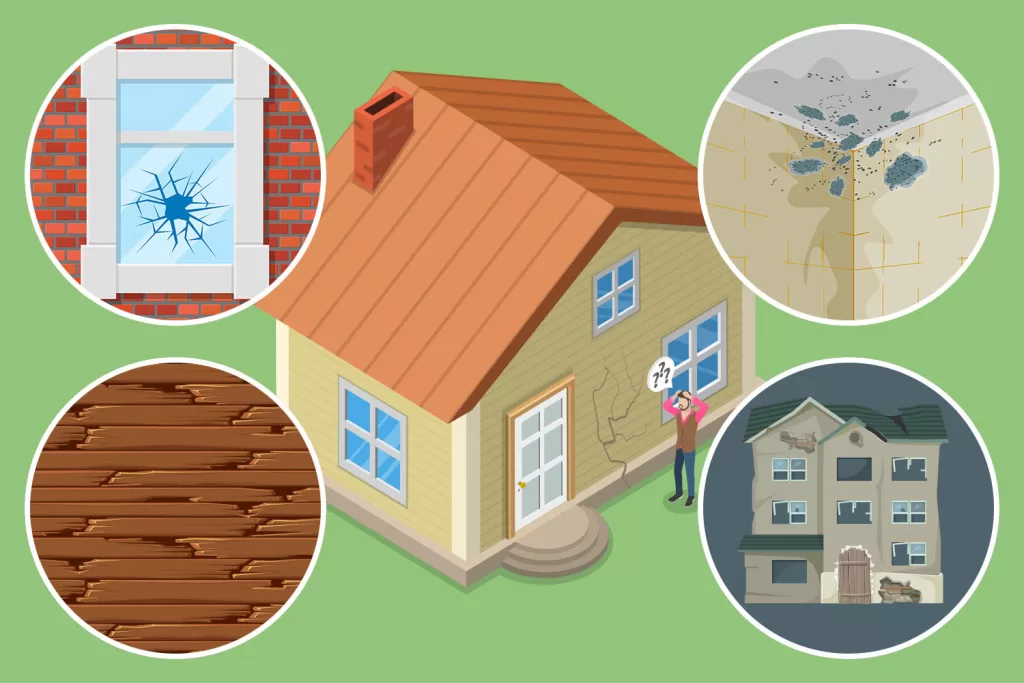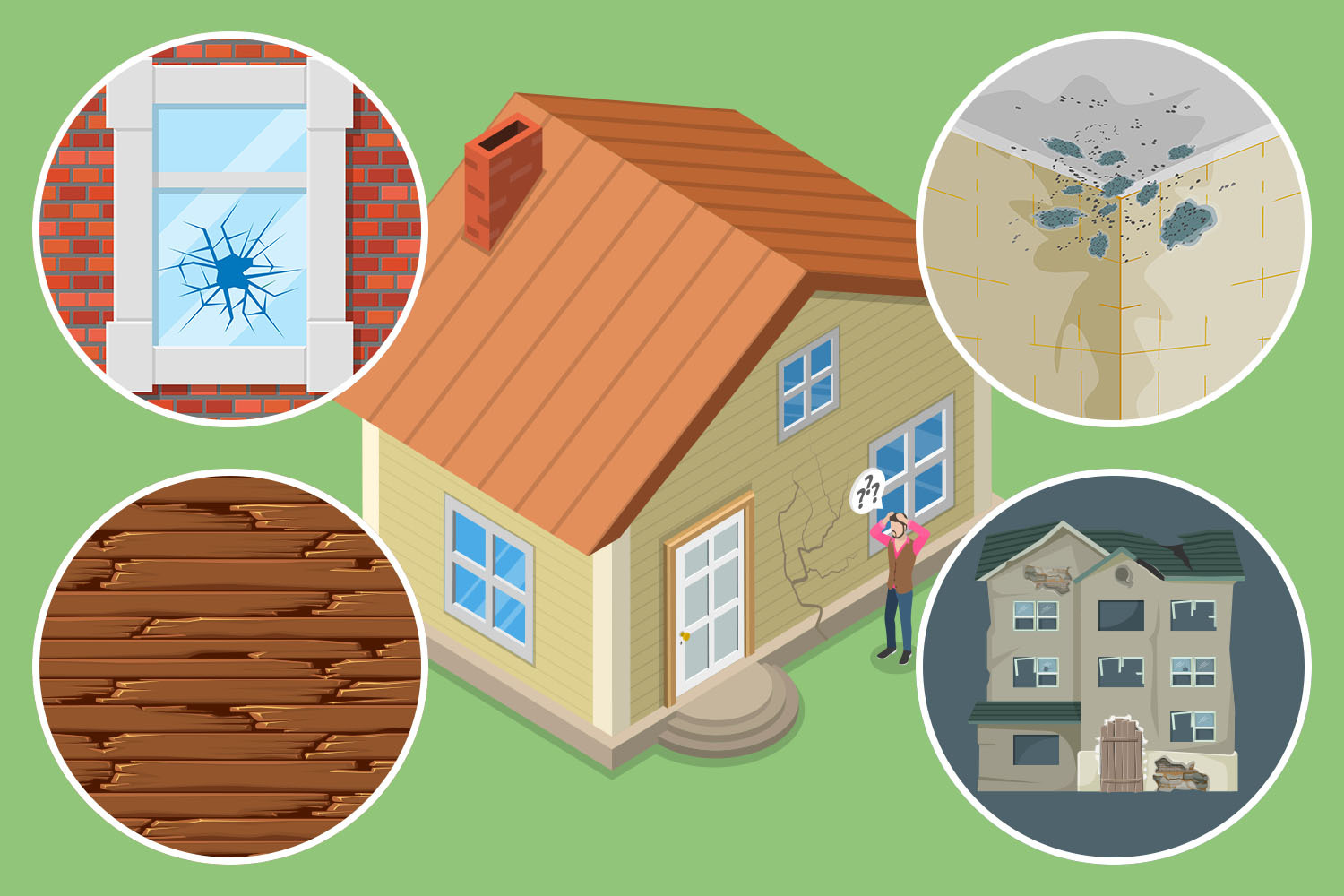Subsidence is where the ground beneath a building sinks, pulling the home’s foundations down with it and causing significant damage to its structure.
It can leave homeowners with hefty bills to fix the damage, and higher insurance premiums long-term too.
Insurers paid around £219million in subsidence claims in 2022, according to the Association of British Insurers (ABI).
This was the highest annual subsidence payout in 16 years since 2006, with the average claim standing at £9,600.
Of the 23,000 subsidence claims made during the year, the majority – 18,000 – were in the second half of the year following a summer heatwave.
This is because hot weather can cause the ground beneath a property to lose moisture and contract, which causes foundations to sink.
With the peak of summer still to come, homeowners may be worried that their house could be at risk and land them with a huge bill.
Most comprehensive buildings insurance should protect you if your home suffers from subsidence, so it’s worth checking your policy protects you – or making sure you have insurance at all, if you don’t currently.
Many mortgage lenders require homeowners to have buildings insurance as a condition of their loan.
Home insurer Homeprotect said it can cost anywhere between £5,000 and £50,000 to protect a property’s foundations, depending on the size of the house and the extent of the damage – not a bill you want to end up with.
How to spot subsidence in your home
The Sun spoke to Liz Hunter, director at Money Expert, who explained how to spot the early signs of subsidence and what homeowners need to do if they find one.
Cracks and issues with windows and doors
The main sign that your property is suffering from subsidence is cracks in the walls, particularly around doors and windows, as they are weak points in a building’s structure.
“These cracks may become bigger and more visible over time, particularly near doors and windows,” Liz explained.
“If you find your doors and windows are sticking, becoming difficult to use, or aren’t opening and closing properly then this could be another sign.”
Large gaps forming in these areas, rather than cracks, may also signal that the problem is getting worse – and this will cost even more to fix.
Liz said: “These issues shouldn’t be ignored and should be checked by a professional quickly to assess the damage and find a cause.
“If it is subsidence, the key is acting quickly to avoid it becoming worse.”
How to save on home insurance
IT’S not just about choosing the best time to take out a home insurance policy – there’s a raft of other ways you can save money.
Pay in full
Most home insurance policies come with 12-month terms and you can pay up front or monthly.
If you’ve got the money to hand, it might be worth opting for the up front payment.
Experts have previously told us that you could save around 10% on your premium by paying for the policy in one lump sum as opposed to monthly.
But the best thing to do is shop around for policies to see which providers will charge you interest on monthly payments.
You can do this on price comparison sites such as Money Supermarket, GoCompare and Compare the Market.
Combine your policies
Home insurance is broken down into two types – buildings insurance and contents insurance.
Buildings insurance covers you if the structure of your home is damaged, including your walls, roof and floors.
Contents insurance covers you for loss or damage to personal items if there is a fire, theft, flooding or other incident.
It essentially covers you for anything not physically attached to your home.
Buildings insurance is usually required if you’ve got a mortgage while contents insurance is normally optional.
But if you are considering buying both types of policies, it might be best to get a combined premium rather than two separate ones.
Never auto-renew
If you’ve already taken out a home insurance policy, it will auto-renew after its term finishes.
This is essentially where your provider will fix a new rate and start charging you for it.
But you should shop around to see if you can get a better quote.
If you find a cheaper one, you can take this to your provider to justify why you want a better price.
Or, you can switch insurers completely.
Uneven floors
Another early sign of a building’s foundations being pulled down may be suddenly sloping or uneven floors.
Liz said: “You may even notice your walls or ceilings bulging or sagging at the same time.
“If you look outside, you may see outside features such as pavements, patios or decking start to tilt or sink too.”
Water marks or issues with wallpaper
If you notice water stains on the walls or ceiling, this could signal subsidence or a leak.
Either way, Liz said you should get it checked out so the problem can be fixed.
“It may mean there are cracks on the exterior walls letting in the rain, which is another early sign of subsidence,” she added.
“Check unusual marks on outside walls such as horizontal cracks or crumbly render.”
If you notice there’s no damp but your wallpaper is starting to crease or even tear – then this could also be a cause for concern.
Liz said: “If you have checked yourself for signs of damp and see no other reason why the wallpaper may be creasing, then it’s best to contact a professional to check the structure of the building for subsidence.”
Property Age
If you live in an older property, there may be a greater risk of subsidence as your home may have shallow foundations.
Liz said: “The foundations may have worn over time or may not have the same quality than a more recently-built home.
“These types of homes will need more regular checks to reduce the risk of subsidence and may even need minor updates or improvements like improving drainage to keep subsidence at bay.”
What happens if there is subsidence in your home?
If you spot subsidence in your home, the next steps will vary on a case-by-case basis depending on the cause of the subsidence.
If your insurer provides subsidence cover, they would look to mitigate the cause.
There are usually two causes of subsidence. These are a leaking drain, which could wash away the finer parts of subsoil, or tree roots taking moisture from the clay underneath a building.
Either way, Liz said it’s important that you act fast and don’t ignore early signs, as leaving it to worsen can lead to to more severe issues for your home that are much more costly to repair.
Once your insurer has established the cause, they will try to repair the subsidence – for example by removing a nearby tree.
In the vast majority of cases this is a simple process, but in a small percentage of more extreme cases you may need to consider more disruptive measures such as underpinning the property.
What impact does claiming for subsidence have on my insurance?
Most insurers will continue to insure a property once it has been repaired for subsidence-related issues, and this work will typically be done through the insurance company.
However, it can be difficult to obtain new cover once you’ve made a subsidence claim on your property, so most customers will need to remain with their current insurer after making a claim.
In some cases, your insurer might agree to a cash settlement rather than repairing the damage themselves, as they may not be able to find the right people to carry out the work.
This means you will need to use the money they give you get to fund your own repair works.
Some insurers might apply conditions to your insurance policy going forward, such as removing cover until the work has been completed.
Subsidence claims can increase your future insurance premiums, though – but there are a number of factors that influence an insurers’ decision and it varies from firm to firm.
David Joyson, chief customer officer at Homeprotect, said: “If you suspect subsidence, you’ll firstly want to check your home insurance policy documents to see if it’s covered.
“In the future – particularly if you’re planning to buy a property where the survey shows you may be at risk of subsidence – it would be wise to switch your policy to a specialist home insurer that will cover you for subsidence, ensuring you fully disclose the subsidence risk that has been identified.”
Advice for homebuyers
If you’re concerned about subsidence, Liz recommended getting a full structural survey done before you buy your home.
You could also get a structural engineer to take a look if you’re worried.
If a property has ongoing subsidence, it could be difficult to market or sell.
This is because in some cases, where the damage is severe, the property could also be uninsurable, which would impact you or any future buyers’ ability to get a mortgage.
It may be worth getting a current homeowner to repair any issues before you buy a property.
Meanwhile, if you’re looking to sell a home which has suffered from subsidence, consider getting it repaired before you put it on the market.
Mr Joyson added: ““There’s not much you can do to prevent subsidence, but there are ways to reduce the risk – including removing trees and bushes planted near the house (although always check larger trees aren’t under a tree preservation order) and if you can’t remove them, then maintain them with regular pruning.”
In other property news, we tested DIY methods of killing garden and patio weeds – and found an amazing 1p trick beat a £9 product.
Plus, Martin Lewis has revealed how renters can get landlords to get rid of black mould – and you could get compensation
Do you have a money problem that needs sorting? Get in touch by emailing money-sm@news.co.uk.
Plus, you can join our Sun Money Chats and Tips Facebook group to share your tips and stories








